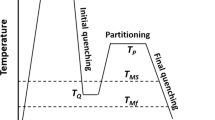Abstract
The objective of the present study is to enhance the resistance of hydrogen embrittlement (HE) via second tempering at 250 °C for 30, 60 and 120 minutes. Although second tempering results in a higher saturated hydrogen content for the second tempering specimens during a slow strain rate test (SSRT), it effectively reduces HE susceptibility. As the second tempering time increases, dislocation density decreases. In contrast, the size of the cementite and MoyCx precipitates increase slightly. The density of MoyCx precipitates increases, whereas the density of cementite remains approximately the same as the second tempering time increases. Regarding second tempering specimens, the volume fraction’s increase in MoyCx precipitates, which acts as a hydrogen trap with high binding energy, plays an important role in reducing the HE susceptibility, and the decrease in dislocation density can also improve HE resistance. In addition, the growth of the interface of the cementite and matrix disperses more hydrogen, which could enhance HE resistance. The result also reveals that the cementite and matrix interface is a type of low-binding-energy hydrogen trap without plastic deformation, whereas the strain interface with interfacial dislocations is a type of high binding energy hydrogen trap under plastic deformation.











Similar content being viewed by others
References
1. T. Doshida, M. Nakamura, H. Saito, T. Sawada and K. Takai: Acta Mater., 2013, vol. 61, pp. 7755-66.
2. A. Nagao, T. Ito and T. Obinata: JFE Tech. Rep., 2008, vol. 11, pp. 13-8.
3. X. Zhu, W. Li, H.S. Zhao and X.J. Jin: Int. J. Hydrogen Energy, 2013, vol. 38, pp. 10694-703.
4. Y. Momotani, A. Shibata, D. Terada and N. Tsuji: Mater. Today: Proc., 2015, vol. 2, pp. S735-8.
S.K. Ji, H.L. You, D.L. Lee, K.T. Park and S.L. Chong (2009) Mater. Sci. Eng. A, vol. 505, pp. 105-10.
6. T. Michler and M.P. Balogh: Int. J. Hydrogen Energy, 2010, vol. 35, pp. 9746-54.
7. M.Q. Wang, E. Akiyama and K. Tsuzaki: Corros. Sci., 2007, vol. 49, pp. 4081-97.
8. K. Takai: Isij Int., 2012, vol. 52, pp. 167.
9. M. Dadfarnia, A. Nagao, S. Wang, M.L. Martin, B.P. Somerday and P. Sofronis: Int. J. Fract., 2015, vol. 196, pp. 1-21.
10. A. Nagao, M.L. Martin, M. Dadfarnia, P. Sofronis and I.M. Robertson: Acta Mater., 2014, vol. 74, pp. 244-54.
W.J. Hui, H.X. Zhang, Y.J. Zhang, X.L. Zhao and C.W. Shao (2016) Mater. Sci. Eng. A, vol. 674, pp. 615-25.
Y. Sakamoto, K. Takao and S. Tokumitsu (1976) Mater. Trans. JIM, vol. 17, pp. 743-8.
13. A. Nagao, K. Hayashi, K. Oi and S. Mitao: Isij Int., 2012, vol. 52, pp. 213-21.
14. H. Fuchigami, H. Minami and M. Nagumo: Philos. Mag. Lett., 2006, vol. 86, pp. 21-9.
15. L.W. Tsay, H.L. Lu and C. Chen: Corros. Sci., 2008, vol. 50, pp. 2506-11.
16. H. Iwaoka, M. Arita and Z. Horita: Acta Mater., 2016, vol. 107, pp. 168-77.
17. P. Castaño-Rivera, N.S.D Vincentis, R.E. Bolmaro and P. Bruzzoni: Procedia Mater. Sci., 2015, vol. 8, pp. 1031-8.
18. C. Park, N. Kang, M. Kim and S. Liu: Mater. Lett., 2019, vol. 235, pp. 193-6.
19. T. Depover and K. Verbeken: Int. J. Hydrogen Energy, 2018, vol. 43, pp. 3050-61.
20. M. Dadfarnia, M.L. Martin, A. Nagao, P. Sofronis and I.M. Robertson: J. Mech. Phys. Solids, 2015, vol. 78, pp. 511-25.
21. M. Nagumo and K. Takai: Acta Mater., 2019, vol. 165, pp.722-33.
22. K. Takai and R. Watanuki: Isij Int., 2003, vol. 43, pp. 520-6.
23. W.M. Robertson and A.W. Thompson: Metall. Trans. A, 1980, vol. 11, pp. 553-7.
24. F.G. Wei, T. Hara, T. Tsuchida and K. Tsuzaki: Trans. Iron Steel Inst. Jpn., 2003, vol. 43, pp. 539-47.
25. F.G. Wei and K. Tsuzaki: Scr. Mater., 2005, vol. 52, pp. 467-72.
26. G.K. Williamson and W.H. Hall: Acta Metall., 1953, vol. 1, pp. 22-31.
27. G.K. Williamson and R.E. Smallman: Philos. Mag., 2012, vol. 1, pp. 34-46.
28. S. Takebayashi, T. Kunieda, N. Yoshinaga, K. Ushioda and S. Ogata: Isij Int., 2010, vol. 50, pp. 875-82.
J.L. Yang, F. Huang, Z.H. Guo, Y.H. Rong and N.L. Chen (2016) Mater. Sci. Eng. A, vol. 665, pp. 76-85.
30. G.W. Hong and J.Y. Lee: Metall. Trans. A, 1983, vol. 14, pp. 156-8.
31. M. Hatano, M. Fujinami, K. Arai, H. Fujii and M. Nagumo: Acta Mater., 2014, vol. 67, pp. 342-53.
32. X. Zhu, W. Li, T.Y. Hsu, S. Zhou, L. Wang and X.J. Jin: Scr. Mater., 2015, vol. 97, pp. 21-4.
33. S.H. Yu, S.M. Lee, S. Lee, J.H. Nam, J.S. Lee, C.M. Bae and Y.K. Lee: Acta Mater., 2019, vol. 172, pp. 92-101.
34. Y.F. Jiang, B. Zhang, D.Y. Wang, Y. Zhou, J.Q. Wang, E.H. Han and W. Ke: J. Mater. Sci. Technol., 2019, vol. 35, pp. 1081-7.
35. C. Park, N. Kang, S. Liu, J. Lee, E. Chun and S.J. Yoo: Met. Mater. Int., 2018, vol. 25, pp. 584-93.
Acknowledgments
This project was supported by the National Natural Science Foundation of China under Grant Nos. U1760203 and 51571029 and the National Key R&D Program of China (2017YFB0304401).
Author information
Authors and Affiliations
Corresponding author
Additional information
Publisher's Note
Springer Nature remains neutral with regard to jurisdictional claims in published maps and institutional affiliations.
Manuscript submitted November 29, 2019.
Rights and permissions
About this article
Cite this article
Wang, Z., Kan, B., Xu, J. et al. The Effect of Second Tempering on Hydrogen Embrittlement of Ultra-High-Strength Steel. Metall Mater Trans A 51, 2811–2821 (2020). https://doi.org/10.1007/s11661-020-05749-6
Received:
Published:
Issue Date:
DOI: https://doi.org/10.1007/s11661-020-05749-6




